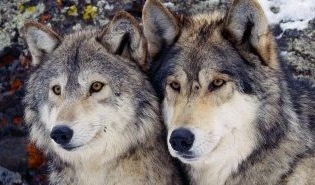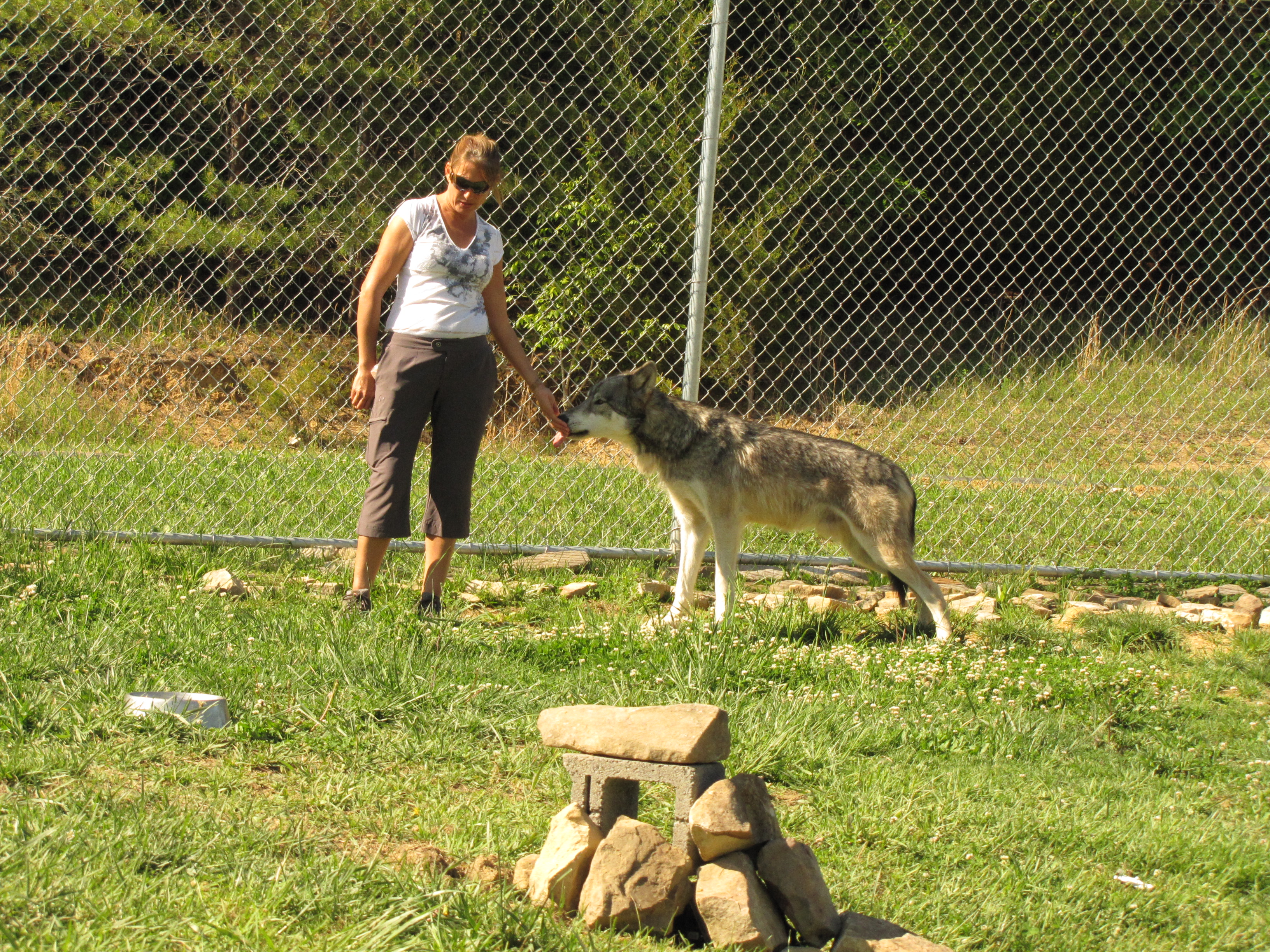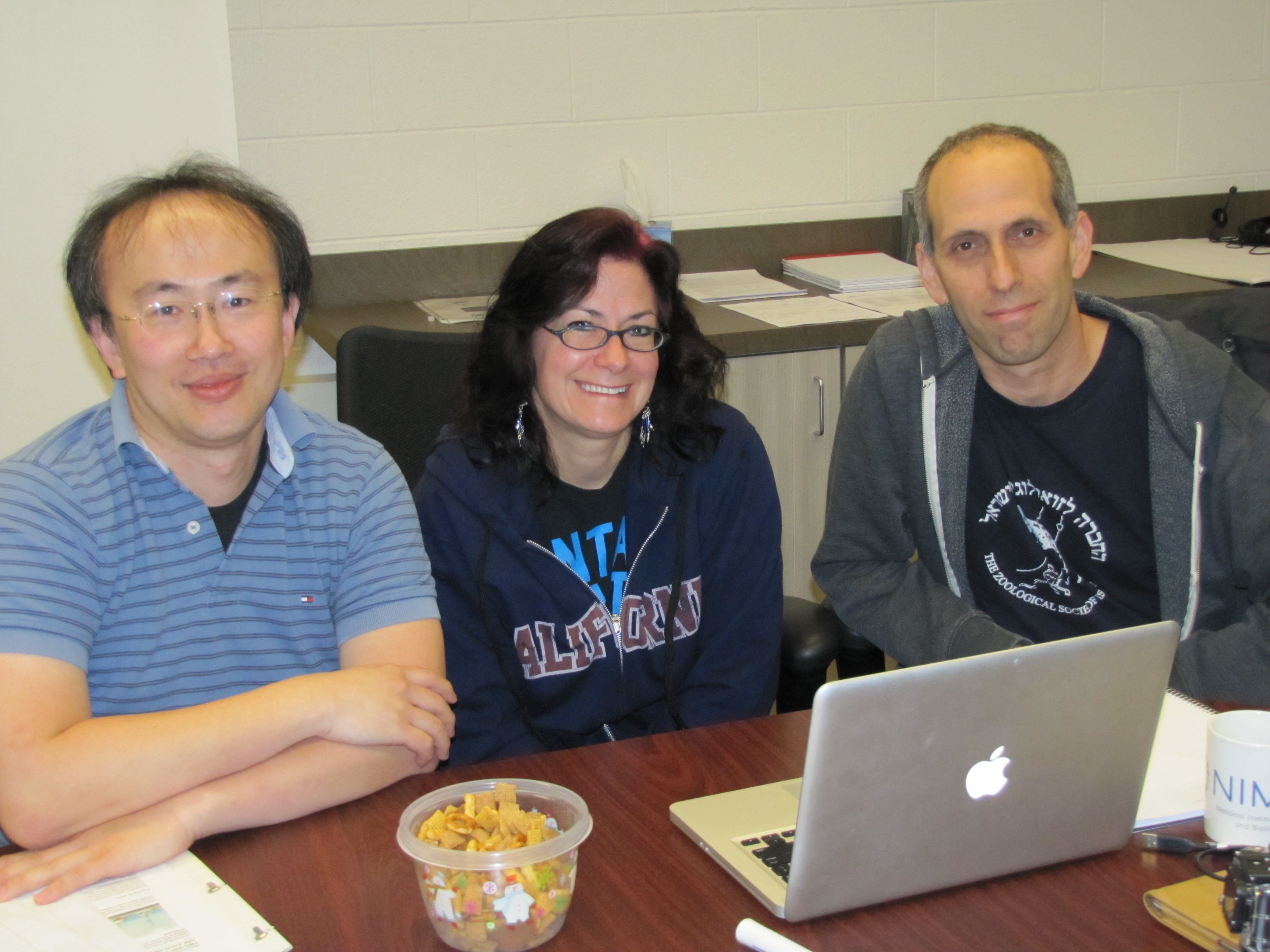Howling for Peace
Waller teams with NIMBioS on ‘Social Predator Vocalization Project’
29 May 2014

Sara Waller is an associate professor of philosophy at Montana State University Bozeman whose research into understanding the vocal behavior of wolves and coyotes brought her to NIMBioS in the spring. With collaborators at NIMBioS and the University of Tennessee, Waller hopes to develop theoretical and computing tools to help listen and distinguish between vocalizations that occur in groups of cooperative predators. The research could lead to new non-violent tools for farmers trying to keep predators away from livestock or for people wishing to enjoy the natural environment while staying out of danger.
In an interview with NIMBioS, Waller elaborated on the goals of the Social Predator Vocalization Project and its potential for helping coyotes and wolves live peaceably with humans. At NIMBioS, Waller worked with postdoctoral fellow Arik Kershenbaum, UTK psychology professor Todd Freeberg and Yu Shiu, a postdoctoral researcher with Cornell University's Bioacoustic Research Program, who also visited NIMBioS during Waller's visit.
Q. What is the Social Predator Vocalization Project?
Much of the human community sees human interaction between wolves, coyotes, and their kin as little more than a war; it's us or them. In Montana and other rural states with ranchers, farmers and livestock, coyotes and wolves who have been displaced from their natural habitat by human activity seek out and kill valuable food animals, such as chickens, young sheep or cows. This leads to laws allowing ranchers to “shoot on sight” any canine predator that crosses the acres of ranchland. Sadly, many of those canines are not hunting, but simply traveling to meet pack-mates.
Part of the vocalization-based research we are doing here at NIMBioS could help us find a non-violent solution: one that allows ranchers to avoid loss of money and livestock while still allowing wild predators to live and flourish. This research is important in that it could result in the discovery of a complex group of calls that could be recorded and played back in varying sequences to keep predator packs away from livestock, and so result in more peaceful co-existence between humans and predators like coyotes and wolves.
Human beings love communing with nature on remote hiking trails and at scenic campsites. One reason this kind of vocalization analysis research is more broadly beneficial is that we know that being in the wilderness eases symptoms of human stress, and yet, we do experience a threat from predatory wildlife as we hike and camp. If we find ways that allow people to be closer to beautiful natural environments while also staying out of danger — through the use of a portable call catalog rather than guns and bear spray — then we would provide valuable assistance for the tourist industry as well.
Q. What are the main goals of the project?
We would like to see how coordination and cooperation happen, and how these are related to specific vocalizations from specific individuals. Just as all workers call to each other — to ask for hammers and nails, or the frying pan and oil, or classmates working together to complete a project, if we can distinguish precisely who says what, and when, and then observe what happens next, we can decode the complex signals these creatures are sending to each other to accomplish an important goal.
For example, imagine a repeated instance of a female coyote on high ground who can see prey in the valley below. She makes two complex sounds: one that draws the attention of her mate and one that draws the attention of her son, and then we observe the mate go left and the son go straight ahead, while she stays in position, and a rabbit is flushed straight into her. As long as these vocalizations and behaviors are consistent, we can decode their meaning. While this example is about hunting maneuvers and coordination, other calls could mean “stay away,” or “I challenge you to a fight,” or “these chickens belong to me.” Group chorus howls could mean something even more interesting, revealing the complexity of social relationships and the strength and nature of social bonds.
The vocalizations could also mean something else altogether. If evolutionary pressures select for social creatures who vocalize when they communicate, but these creatures have evolved to perceive and conceive of the world very differently, with different goals and thought processes, then this research could contribute to SETI (Search for Extraterrestrial Intelligence) and help us communicate with ET. Canids are a highly evolved, complex, communicative species. If the aliens don't have radio telescopes, maybe they howl. And maybe, just maybe, we can howl back in a ways that fosters peace and information sharing rather than invasion and destruction.
Q. How did you begin interested in this research?
I have always been interested in animals and how they must think differently from the way humans do. After I finished my dissertation on philosophy of language at Loyola University Chicago in 2000, I did an internship at San Diego State University with the Cetacean Behavior Project. I realized that the questions researchers have about dolphin vocalizations were the same questions that philosophers have about the nature of human meaning and language use. There are no theories that explain fully how human language works, so maybe animal vocalizations and the way that they signal to each other can give us insight into our own minds and how we represent and understand the world. I got my first grant for recording dolphin vocalizations in 2001 and have been going ever since.
Q. How did NIMBioS factor in to your project?
NIMBioS held a workshop on the analysis of animal vocalization sequences in October 2013, and I was fortunate enough to be one of the participants. The October meeting was a fantastic combination of mathematicians, biologists, and animal researchers focused on a broad range of species, from marmots to dolphins to white gibbons to coyotes. My small project was a simple exploration into the ways in which coyotes vocalize differently when they are in urban environments like Los Angeles, CA, and rural environments, like the outskirts of Bozeman, MT. Now, I know that I'm asking the same questions as other researchers working with different species around the globe, and hoping to use the same developing mathematical methods and models to try to answer those questions. So, Arik Kershenbaum and I have expanded and built on our concurrent projects, such as his Canid Howl Project, into the “Cooperative Predator Vocalization Consortium.” Cooperative predators share the goal of obtaining prey, and many coordinate their actions through vocalization. Right now, we are focusing on wolves, coyotes, and other canids, but the possibilities of the kinds of creatures that could eventually be included are vast and exciting.
NIMBioS is a fabulous resource. I've never made more solid progress on my research so quickly. And everyone here collaborates so well and easily together. NIMBioS is a place of genius, inhabited by collaborative, vocalizing geniuses, who are obviously helping the world in a variety of ways.

|
| Waller and her team collected recordings at Wolf PAWS Inc. (Positive Awareness Wolf-dog Sanctuary) in Dandridge, TN. Director Jennifer Ackley feeds one of the wolves. Photo Credit: Arik Kershenbaum |

|
| (From left) Yu Shiu, Sara Waller and Arik Kershenbaum meet at NIMBioS to collaborate on the Social Predator Vocalization Project. |
NIMBioS
1122 Volunteer Blvd., Suite 106
University of Tennessee
Knoxville,
TN 37996-3410
PH: (865) 974-9334
FAX: (865) 974-9461
Contact NIMBioS


